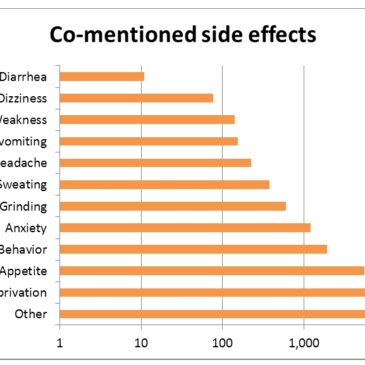Growing research suggests that social media data can fuel the emergence of technology-enhanced public health monitoring. For example, Signorini and colleagues (2011) used Twitter as a tool to survey and predict H1N1 (swine flu) outbreaks. Recently, researchers have started to examine whether social media data provide valuable public health information for behavioral disorders, such as addictive behavior. This week’s STASH examines a study that used Twitter status messages to monitor mentions of misuse of Adderall, a psychostimulant often prescribed as a medication for ADHD (Hanson, Burton, Giraud-Carrier, West, & Barnes, 2013).
Methods
- The researchers used software[1] that enables Twitter users to retrieve tweets[2] in “real-time” based on search criteria to find tweets relating to Adderall use and its side effects; they monitored tweets from November 2011-May 2012.
- The researchers examined the tweets for (1) mentions of non-medical Adderall use, instances of co-abused substances (e.g. alcohol, cocaine, marijuana) (2) co-mentioned side effects (e.g. loss of appetite, sleep deprivation, Obsessive Compulsive Behavior). and (3) rates of tweeting by hour, day, and week.
Results
- The researchers identified 213,633 tweets mentioning the term Adderall from 132,099 unique user accounts in the United States.
- Of those tweets, 27,472 (approximately 13%) reference Adderall used as a study aid, rather than as medication for ADHD . For instance, one tweet consisted of “Adderall stockpile for finals.”
- The researchers saw fluctuations in Adderall-related tweeting over time: Tweets mentioning Adderall were most frequent toward the middle of the week. Looking over a year, the most Adderall tweets occurred during December and May.
- There were several co-mentioned substances in Adderall-related tweets. The substances described most frequently were alcohol (mentioned in 4.8% of Adderall-related tweets) and other stimulants (mentioned in 4.7% of Adderall-related tweets)
- There was an “other category” (representing 11.3% of Adderall-related tweets) which was composed of unique mentions of other substances. For instance, one tweet consisted of “Adderall, Coffee, Red Bull. Epic Focus. Or a heart attack.”
- The researchers observed a number of co-mentioned side effects related to Adderall use, including sleep deprivation (mentioned in 5% of Adderall-related tweets), appetite loss (mentioned in 2.6% of Adderall-related tweets), and Obsessive Compulsive Behavior (mentioned in approximately1% of Adderall-related tweets) (see Figure 1).

Figure. A log-scale of commonly-mentioned side effects in Adderall-related tweets. “Other” refers to unique mentions of side-effects (i.e. they did not come from the set of keywords used by the researchers). Click image to enlarge.
Limitations
- Although the researchers observed interesting patterns, they have not calibrated the tweets to actual behavior, so we do not know how Adderall-tweeting tracks to actual use.
- A large number of the Adderall-tweets were song lyrics which are not necessarily related to actual Adderall use by tweeters.
- This study only looked at publicly available tweets; however, Twitter also allows users to send direct messages privately to one another.
Discussion
Twitter may be a new milieu in which to track trends in public health, including behavioral health. Students who are using Adderall as a study aid likely represent a large proportion of people sending these tweets. This conclusion is supported both by the subset of tweets that explicitly mentioned Adderall used as a study aid (13%), and by the observed fluctuation in tweets (i.e., that users tended to tweet about Adderall during the middle of the week and especially during December and May, when schools traditionally hold final exams). Beyond public health monitoring, social media, including Twitter, could provide a simple and easily accessible way to disseminate public health information and health promotion messages.
-Emily Shoov
What do you think? Please use the comment link below to provide feedback on this article.
References
Hanson, C.L., Burton, S.H., Giraud-Carrier, C., West, J.H., & Barnes, M.D., (2013) Tweaking and Tweeting: Exploring Twitter for Nonmedical Use of a Psychostimulant Drug (Adderall) Among College Students. Journal of Medical Internet Research. 15(4): e62
Signorini A, Segre AM, & Polgreen PM (2011) The Use of Twitter to Track Levels of Disease Activity and Public Concern in the U.S. during the Influenza A H1N1 Pandemic. PLoS ONE 6(5): e19467.
________________
[1]The publicly available Twitter API (Application Programming Interface)
[2] A “tweet” is a 140-character or less status messages posted by individuals on Twitter




